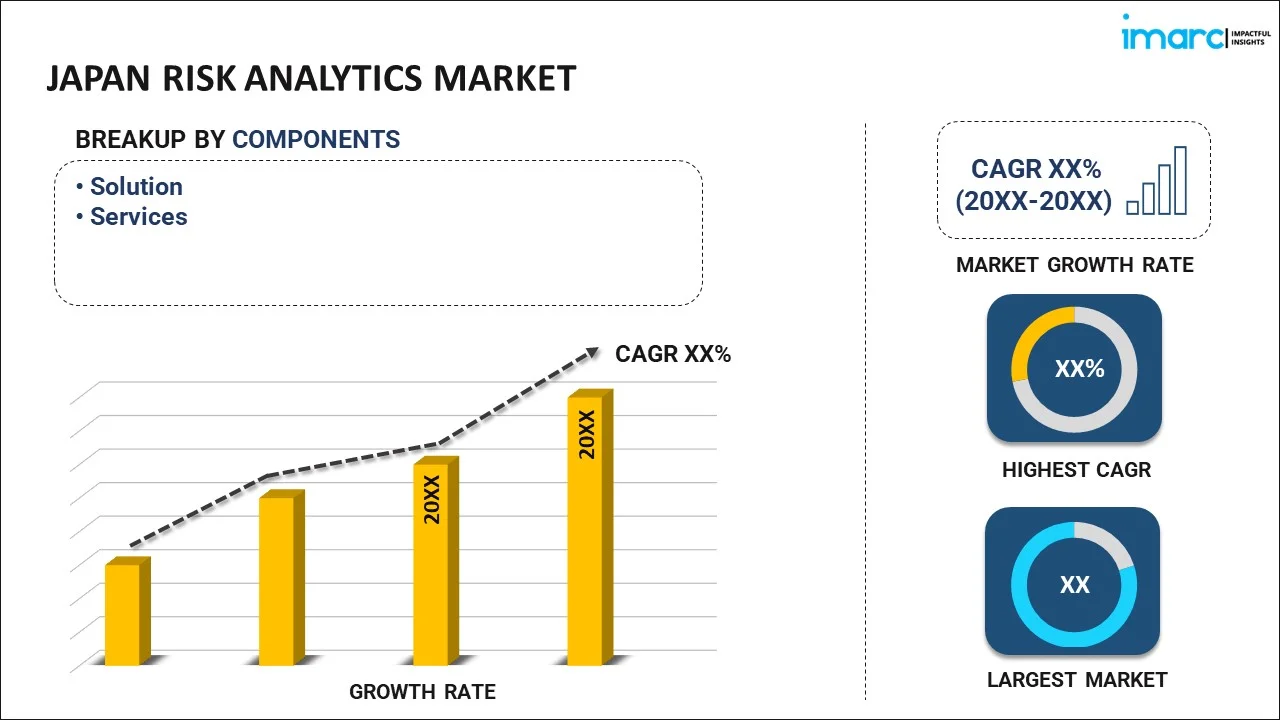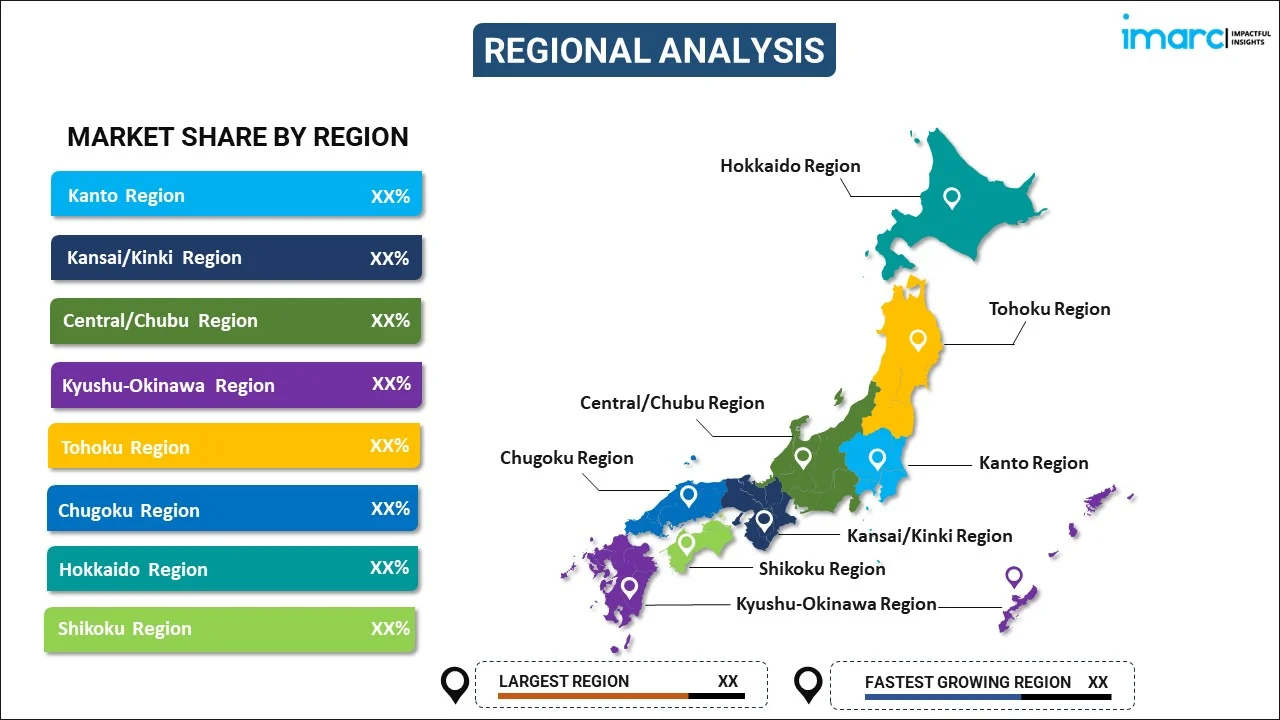
Japan Risk Analytics Market Report by Component (Solution, Services), Deployment Mode (On-premises, Cloud-based), Organization Size (Large Enterprises, Small and Medium Enterprises), Application (Strategic Risks, Financial Risks, Operational Risks, Compliance Risks), Industry Vertical (BFSI, IT and Telecom, Retail, Healthcare, Energy and Utilities, Manufacturing, Government and Defense, and Others), and Region 2025-2033
Market Overview:
Japan risk analytics market size reached USD 2,306 Million in 2024. Looking forward, IMARC Group expects the market to reach USD 6,546 Million by 2033, exhibiting a growth rate (CAGR) of 12.3% during 2025-2033. The increasing proliferation of data from various sources, including social media, IoT devices, and customer interactions, which creates opportunities for more comprehensive risk analysis, is driving the market.
|
Report Attribute
|
Key Statistics
|
|---|---|
|
Base Year
|
2024 |
|
Forecast Years
|
2025-2033
|
|
Historical Years
|
2019-2024
|
| Market Size in 2024 | USD 2,306 Million |
| Market Forecast in 2033 | USD 6,546 Million |
| Market Growth Rate (2025-2033) | 12.3% |
Risk analytics is the process of using data analysis and mathematical models to assess and manage various types of risks within an organization or financial system. It involves collecting and analyzing data to identify potential risks, quantifying their impact, and developing strategies to mitigate or manage them effectively. In the financial sector, risk analytics plays a crucial role in evaluating market, credit, and operational risks. It helps financial institutions make informed decisions regarding investments, lending, and risk exposure. By examining historical data, market trends, and statistical models, risk analysts can estimate the likelihood of adverse events and their potential consequences. Beyond finance, risk analytics is also applied in industries such as insurance, healthcare, and supply chain management. It aids in optimizing resource allocation, improving decision-making, and enhancing overall risk awareness. As data and technology continue to advance, risk analytics becomes increasingly essential for businesses and organizations to navigate uncertain environments and make informed choices to safeguard their interests.
Japan Risk Analytics Market Trends:
The risk analytics market in Japan is thriving due to several key drivers. Firstly, the increasing complexity of financial markets, coupled with regulatory requirements, has necessitated the adoption of advanced risk analytics tools. Consequently, organizations are investing heavily in these solutions to ensure compliance and maintain their competitive edge. Moreover, the growing volume of data generated by businesses is another pivotal factor. As data becomes more abundant, the need to harness it for risk assessment and mitigation becomes paramount. This surge in data is driving the demand for sophisticated analytics tools that can provide real-time insights and predictive modeling. Additionally, the escalating importance of risk analytics in supply chain management and crisis response. Organizations are keen on fortifying their risk management frameworks, making risk analytics solutions indispensable in today's uncertain business environment. Furthermore, the rise of digital transformation, along with increased risks, including cybersecurity threats and operational disruptions, which require advanced analytics to identify vulnerabilities and develop proactive strategies, is expected to drive the risk analytics market in Japan during the forecast period.
Japan Risk Analytics Market Segmentation:
IMARC Group provides an analysis of the key trends in each segment of the market, along with forecasts at the country level for 2025-2033. Our report has categorized the market based on component, deployment mode, organization size, application, and industry vertical.
Component Insights:

- Solution
- Services
The report has provided a detailed breakup and analysis of the market based on the component. This includes solution and services.
Deployment Mode Insights:
- On-premises
- Cloud-based
A detailed breakup and analysis of the market based on the deployment mode have also been provided in the report. This includes on-premises and cloud-based.
Organization Size Insights:
- Large Enterprises
- Small and Medium Enterprises
The report has provided a detailed breakup and analysis of the market based on the organization size. This includes large enterprises and small and medium enterprises.
Application Insights:
- Strategic Risks
- Financial Risks
- Operational Risks
- Compliance Risks
A detailed breakup and analysis of the market based on the application have also been provided in the report. This includes strategic risks, financial risks, operational risks, and compliance risks.
Industry Vertical Insights:
- BFSI
- IT and Telecom
- Retail
- Healthcare
- Energy and Utilities
- Manufacturing
- Government and Defense
- Others
The report has provided a detailed breakup and analysis of the market based on the industry vertical. This includes BFSI, IT and telecom, retail, healthcare, energy and utilities, manufacturing, government and defense, and others.
Regional Insights:

- Kanto Region
- Kansai/Kinki Region
- Central/ Chubu Region
- Kyushu-Okinawa Region
- Tohoku Region
- Chugoku Region
- Hokkaido Region
- Shikoku Region
The report has also provided a comprehensive analysis of all the major regional markets, which include Kanto Region, Kansai/Kinki Region, Central/ Chubu Region, Kyushu-Okinawa Region, Tohoku Region, Chugoku Region, Hokkaido Region, and Shikoku Region.
Competitive Landscape:
The market research report has also provided a comprehensive analysis of the competitive landscape in the market. Competitive analysis such as market structure, key player positioning, top winning strategies, competitive dashboard, and company evaluation quadrant has been covered in the report. Also, detailed profiles of all major companies have been provided.
Japan Risk Analytics Market Report Coverage:
| Report Features | Details |
|---|---|
| Base Year of the Analysis | 2024 |
| Historical Period | 2019-2024 |
| Forecast Period | 2025-2033 |
| Units | Million USD |
| Scope of the Report | Exploration of Historical Trends and Market Outlook, Industry Catalysts and Challenges, Segment-Wise Historical and Future Market Assessment:
|
| Components Covered | Solution, Services |
| Deployment Modes Covered | On-premises, Cloud-based |
| Organization Sizes Covered | Large Enterprises, Small and Medium Enterprises |
| Applications Covered | Strategic Risks, Financial Risks, Operational Risks, Compliance Risks |
| Industry Verticals Covered | BFSI, IT and Telecom, Retail, Healthcare, Energy and Utilities, Manufacturing, Government and Defense, Others |
| Regions Covered | Kanto Region, Kansai/Kinki Region, Central/ Chubu Region, Kyushu-Okinawa Region, Tohoku Region, Chugoku Region, Hokkaido Region, Shikoku Region |
| Customization Scope | 10% Free Customization |
| Post-Sale Analyst Support | 10-12 Weeks |
| Delivery Format | PDF and Excel through Email (We can also provide the editable version of the report in PPT/Word format on special request) |
Key Questions Answered in This Report:
- How has the Japan risk analytics market performed so far and how will it perform in the coming years?
- What has been the impact of COVID-19 on the Japan risk analytics market?
- What is the breakup of the Japan risk analytics market on the basis of component?
- What is the breakup of the Japan risk analytics market on the basis of deployment mode?
- What is the breakup of the Japan risk analytics market on the basis of organization size?
- What is the breakup of the Japan risk analytics market on the basis of application?
- What is the breakup of the Japan risk analytics market on the basis of industry vertical?
- What are the various stages in the value chain of the Japan risk analytics market?
- What are the key driving factors and challenges in the Japan risk analytics?
- What is the structure of the Japan risk analytics market and who are the key players?
- What is the degree of competition in the Japan risk analytics market?
Key Benefits for Stakeholders:
- IMARC’s industry report offers a comprehensive quantitative analysis of various market segments, historical and current market trends, market forecasts, and dynamics of the Japan risk analytics market from 2019-2033.
- The research report provides the latest information on the market drivers, challenges, and opportunities in the Japan risk analytics market.
- Porter's five forces analysis assist stakeholders in assessing the impact of new entrants, competitive rivalry, supplier power, buyer power, and the threat of substitution. It helps stakeholders to analyze the level of competition within the Japan risk analytics industry and its attractiveness.
- Competitive landscape allows stakeholders to understand their competitive environment and provides an insight into the current positions of key players in the market.
Need more help?
- Speak to our experienced analysts for insights on the current market scenarios.
- Include additional segments and countries to customize the report as per your requirement.
- Gain an unparalleled competitive advantage in your domain by understanding how to utilize the report and positively impacting your operations and revenue.
- For further assistance, please connect with our analysts.
 Inquire Before Buying
Inquire Before Buying
 Speak to an Analyst
Speak to an Analyst
 Request Brochure
Request Brochure
 Request Customization
Request Customization




.webp)




.webp)












